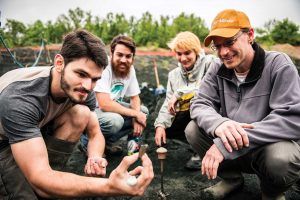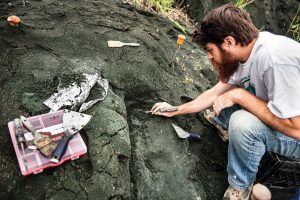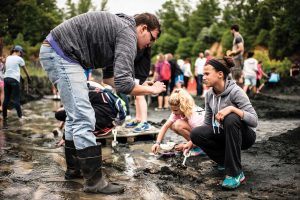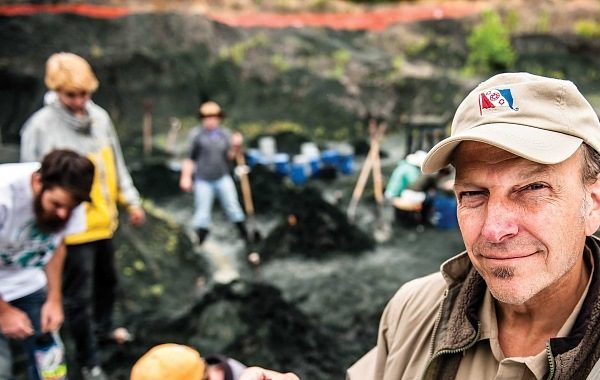 A few times an hour, one fresh-faced college student stands up looking utterly triumphant. Filthy up to her wrists, she’s holding a treasure she’s pulled out of the ground behind a shopping center in Mantua Township. Other students rush over to see, but within a few minutes they’ve all crouched down again – back to the painstaking work of uncovering 65 million-year-old riches.
A few times an hour, one fresh-faced college student stands up looking utterly triumphant. Filthy up to her wrists, she’s holding a treasure she’s pulled out of the ground behind a shopping center in Mantua Township. Other students rush over to see, but within a few minutes they’ve all crouched down again – back to the painstaking work of uncovering 65 million-year-old riches.
This is the Fossil Park at Mantua Township, where paleontologists are finding ancient remains that could solve the mystery of what happened to the dinosaurs.
The land, once a marl pit, has been owned by The Inversand Company for nearly 100 years. The company once excavated manganese greensand, an emerald-hued mineral used for water filtration systems. It’s abundant in the pit’s soil, because the area was once a prehistoric sea floor. The Inversand Company suspended its operations in 2012, leaving behind 65 acres filled with a staggering number of fossilized teeth, shells and bones dating from the late Cretaceous Period.
The site is now the domain of paleontologist Ken Lacovara, PhD. He built an international reputation in the dinosaur world with the 2005 discovery of Dreadnoughtus – a two-story, 60-ton behemoth – in Patagonia, Argentina. If the Swedesboro native’s hypothesis is correct, the greatest discovery of his life is here in South Jersey.
“This area was mined as early as 1888, and since the 1920s paleontologists have been collecting fossils here,” Lacovara says.
“They’ve always done what we call salvage paleontology – following the bulldozers around and picking up what’s left behind. Now that we’ve been able to stabilize a section of the quarry, we’ve realized that what we have here could be of true global significance.”
There are only about 300 locations throughout the world where scientists have discovered what they call an “impact layer” filled with minerals and atomic particles that prove a catastrophic event occurred to end the Cretaceous Period.
Scientists say the catastrophe occurred when an asteroid crashed into Earth, wiping out 65 percent of life. The fossils of the creatures killed are preserved in the impact layer. But none of the 300 locations have ever produced a large, unbroken fossil – until now. Lacovara has uncovered a large number of intact fossilized skeletons, what he calls a “mass death assemblage,” in the impact layer.
“The mass death assemblage is in a layer of sediment about 6 inches wide,” Lacovara says. “The many skeletons we’re finding here are articulated [whole], and they’re in the same layer, which means they weren’t moved after they died. It’s very likely they all died at the same time. But was it the same day? Was it the day the asteroid hit? We don’t know the answer yet, but if it turns out to be true it’ll be the only place in the world – and it’s a pit behind a Lowe’s in Mantua Township.”

Graduate students excavate the impact layer at The Fossil Park as part of Ken Lacovara’s class
Lacovara leads a team of current and former students ranging from college freshmen to PhD candidates at the park each Friday. The students excavate the impact layer a millimeter at a time, uncovering fossilized clams and oysters, turtle and snail shells, shark and crocodile vertebrae, shark teeth, and bird and fish bones.
“At first, I’d have students come out here some days and meet me in the classroom other days,” Lacovara says. “But at this point I’ve just ditched the classroom, and my students are learning so much more. I call this my one-room schoolhouse. A lot of the students here aren’t even in my classes anymore – they just keep coming.”
There have been some large discoveries at the park, including a number of new fish species, a nearly complete sea turtle shell and a new species of the giant crocodile genus Thoracosaurus. The students have even unearthed dinosaur bones with what appear to be shark bites.
Though the work of Lacovara’s students is focused on the impact layer, the sediment above also contains fossils, which, though not scientifically significant, are wildly abundant and easy to find. As far as Lacovara is concerned, that makes the park the perfect place to introduce younger students to the world of vertebrate paleontology.
“Paleontologists typically try to keep their sites secret,” Lacovara explains. “Obviously you don’t want a bunch of other scientists showing up to your big discovery. But with this spot I guess we sort of went the other direction. From the very beginning, I’ve been so excited about the educational component, and I wanted to share this with the community and with our young students. I want to show them that science isn’t just in a textbook, and the ancient past isn’t just in far-off places. It’s right here, being uncovered by regular people.”

Students of all ages explore the pit
Working in tandem with Mantua Township, Lacovara and his team have welcomed more than 8,000 area students – from elementary age to high school seniors – on field trips to the park just this year. The students participate in workshops about South Jersey’s ancient past, and then enter the pit to dig for fossils. The students come equipped with large Ziplock bags to carry home most of the fossils they uncover.
“Any kid who tries, even a little bit, is going home with a 65-million-year-old fossil,” Lacovara says. “Once in a while, a kid will find something we haven’t seen before, and we can’t let him take it home. We take their photo, and when that fossil is catalogued and ultimately displayed, it will have a plaque that says it was discovered by that student.”
On Fridays throughout the spring and fall, hundreds of South Jersey students flood the park. But Michelle Bruner, Mantua Township’s economic development coordinator, says that hasn’t been nearly enough to accommodate everyone who wants to come.
“Right now I have 77 schools on a waiting list,” she says. “It’s magic every time we host an event. It’s the coolest field trip I can possibly imagine.”
It’s not just students and teachers who want a chance to practice their paleontology. Four years ago, Bruner organized a Community Dig Day in an effort to get all Mantua’s residents excited about the fossil park.
“The first time, I knew we’d have 400 people, because I’d invited them,” Bruner says. “But then the newspaper ran a blurb about it, and all of a sudden there was a huge line of people waiting to come in. People waited in line for more than an hour.”
In the years since, the 1,500 registration slots for Community Dig Day have filled within minutes, in addition to a waiting list of several hundred more. Lacovara likens getting a spot on the list to “getting Grateful Dead tickets.”
Lacovara and Bruner, along with Mantua Township officials, worked through a number of challenges to turn the pit into the functioning fossil park it is today – including preventing the entire site from becoming a lake.
“The top of the water table is 8 feet below the surface here, and we’re 40 feet down,” Lacovara says. “A pump house pumps out 57 gallons of water per minute. If that were to stop, the entire thing would be filled with water in a matter of days. That’s been the fate of almost all the other thousands of marl pits up and down the East Coast.”
Lacovara imagines a far different future for this particular hole in the ground. He believes it will eventually be designated a UNESCO World Heritage Site, and he’s dedicated to ensuring the park is preserved for the enjoyment of generations.
“I look around here now and I know all we have is a shed and some porta-potties,” he says. “But I can’t help but see 10 years in the future, when there’s a huge, $20 million glass-walled visitors’ center at the top of the ridge, with a huge museum, laboratories, classrooms, a gorgeous veranda overlooking the park where people can get married. It’ll really be something.
“Most people go to museums – even great museums – twice in their lives: they go once as children, and they come back once with their own children,” Lacovara says. “But there is something about the promise of this spot that brings people back here again and again. The discoveries we’re making here are great for science, and the hometown connection to the ancient past is great for this community. This is an important chapter in the history of the whole planet.”












